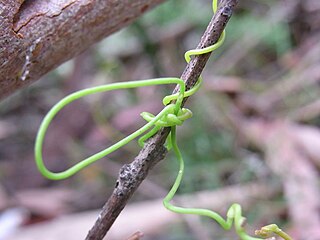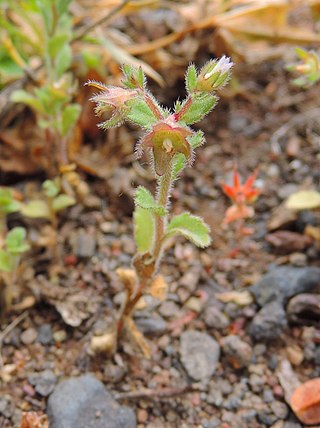
Lauraceae, or the laurels, is a plant family that includes the true laurel and its closest relatives. This family comprises about 2850 known species in about 45 genera worldwide. They are dicotyledons, and occur mainly in warm temperate and tropical regions, especially Southeast Asia and South America. Many are aromatic evergreen trees or shrubs, but some, such as Sassafras, are deciduous, or include both deciduous and evergreen trees and shrubs, especially in tropical and temperate climates. The genus Cassytha is unique in the Lauraceae in that its members are parasitic vines. Most laurels are highly poisonous.

Cassytha is a genus of some two dozen species of obligately parasitic vines in the family Lauraceae. Superficially, and in some aspects of their ecology, they closely resemble plants in the unrelated genus Cuscuta, the dodders. When fruit and flowers are absent in the field, the physical resemblance is so close that few people without technical training can discern the difference. In this respect and in their ecology the two genera present a spectacular example of convergent evolution. Nonetheless, Nickrent comments that "Cassytha is uneqivocally assigned to Lauraceae based on (both) morphological and molecular data." In its divergence from habits typical of the Lauraceae, Cassytha also presents examples of mosaic evolution

Prosotas dubiosa, the tailless lineblue or small purple lineblue, is a blue butterfly (Lycaenidae) found in Asia to Australia. The species was first described by Georg Semper in 1879.

Candalides is a large genus of butterflies in the family Lycaenidae. The species of this genus are found in the Australasian realm.

Catochrysops panormus, the silver forget-me-not, is a small butterfly found from India to the Philippines and south to Australia that belongs to the lycaenids or blues family. The species was first described by Cajetan Felder in 1860.

Philiris is a genus of butterflies in the family Lycaenidae. The species of this genus are found in the Australasian realm, mostly inhabiting tropical rainforests. Philiris was erected by Julius Röber in 1891. It is a speciose genus. Tite decided on 56 species. Sands added 11 species and placed the taxa into 21 species groups. Most species are on New Guinea. Tite considered Philiris and Candalides Hübner, 1819 to be sisters. Eliot (1973) placed Philiris in Luciini Waterhouse & Lyell, 1914, close to Hypochrysops C. et R. Felder, 1860. Compared to other members of the tribe, Philiris have relatively uniform ventral patterns with usually silvery-white ground color.

Titea is a genus of butterflies in the family Lycaenidae.

Cassytha melantha is a parasitic vine. Common names include coarse dodder-laurel and large dodder-laurel. The fruits are about 10–15 millimetres (0.39–0.59 in) in diameter and are green, drying to black. These are edible and are harvested in the wild.

Jameela is a genus of butterflies in the family Lycaenidae.

Jameela palmyra, the marbled blue, is a butterfly in the family Lycaenidae. It is found in along the coast of Australia, as well as in Indonesia, New Guinea and the Solomon Islands.

Cassytha glabella, commonly known as the slender devil's twine, is a common twining plant of the Laurel family, found in many of the moister parts of Australia. A hemi-parasitic climber. The specific epithet glabella is from Latin, referring to the lack of hairs. The fruit are sweet and mucousy to taste. The Devil's Twine and Cassytha melantha are similar, but with thicker hairier stems.

Cassytha filiformis or love-vine is an orangish, wiry, parasitic vine in the family Lauraceae. It is found in coastal forests of warm tropical regions worldwide including the Americas, Indomalaya, Australasia, Polynesia and tropical Africa.

Erysichton lineatus, the hairy line-blue, is a butterfly in the family Lycaenidae. It is the sole species of the genus Erysichton. It was first described by Richard Paget Murray in 1874. It is found in New Guinea and along most of the eastern coast of Australia, from Queensland to New South Wales.

Catopyrops ancyra, or Felder's lineblue, is a species of butterfly belonging to the lycaenid family described by Cajetan Felder in 1860. It is found in the Indomalayan and Australasian realms.

Catopyrops florinda, the speckled line blue, is a species of butterfly belonging to the lycaenid family described by Arthur Gardiner Butler in 1877. It is found in the Australasian realm.

Cassytha racemosa is a parasitic perennial in the Lauraceae family. It is found in Western Australia.

Campanula erinus is a species of annual herb in the genus Campanula (bellflowers). They have a self-supporting growth form. Individuals can grow to 11 cm tall.















